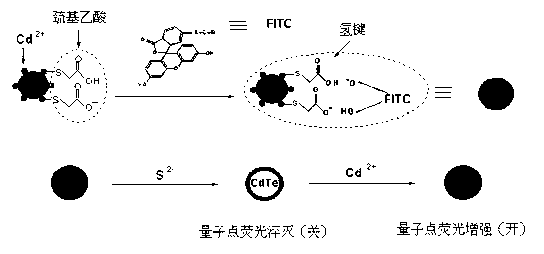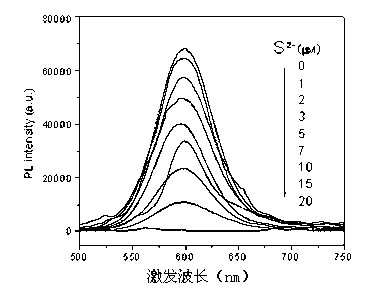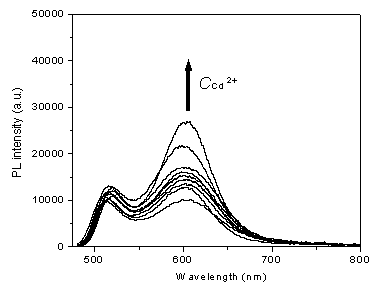Quantum dot-organic dye compound closed/open type cadmium ion ratio fluorescent probe and preparation method thereof
A ratiometric fluorescent probe and organic dye technology, applied in the field of preparation of off/on cadmium ion ratiometric fluorescent probes, can solve the problems of poor selectivity and low sensitivity, and achieve the effects of low cost, excellent luminescence performance and reduced interference
- Summary
- Abstract
- Description
- Claims
- Application Information
AI Technical Summary
Problems solved by technology
Method used
Image
Examples
Embodiment 1
[0027] The preparation process of CdTe-FITC complex off / on type cadmium ion ratio fluorescent probe is as follows: figure 1 As shown, the detailed preparation steps are as follows: First, 40 nM CdTe QDs (maximum fluorescence emission peak wavelength lambda 595nm) solution, weigh a certain amount of FITC ( lambda =520nm) was dissolved in ultrapure water, and the concentration was adjusted to 80 nM. Then, under room temperature and slow magnetic stirring, FITC was added dropwise to the QDs solution to form a FITC-QDs complex, in which the concentrations of QDs and FITC were adjusted to 30 nM and 60 nM, respectively. Next, a standard concentration of S 2- solution, added dropwise to the complex system, to obtain a series of different S 2- Concentration of complex samples, the QDs and FITC concentrations were adjusted to 20 nM and 40 nM, S 2- The concentrations were 0, 1, 2, 3, 5, 7, 10, 15 and 20 μM in sequence. The emission spectrum of each sample was measured by fluoresc...
Embodiment 2
[0029] First, 50 nM CdTe QDs were prepared in phosphate buffer (PBS, pH = 6.5) ( lambda =595nm) solution, weigh a certain amount of FITC ( lambda =520nm) was dissolved in ultrapure water, and the concentration was adjusted to 100 nM. Then, under room temperature and slow magnetic stirring, FITC was added dropwise into the QDs solution to form a FITC-QDs complex, in which the concentrations of QDs and FITC were adjusted to 40 nM and 80 nM, respectively. Next, a standard concentration of S 2- solution, added dropwise to the complex system, to obtain a series of different S 2- Concentration of complex samples, where the concentration of QDs and FITC were adjusted to 30 nM and 60 nM, S 2- The concentrations were 0, 1, 2, 3, 5, 7, 10, 15, 20 and 25 μM in sequence. The emission spectrum of each sample was measured by fluorescence spectrometry, the excitation wavelength was 470 nm, and the average value of 6 measurements was taken as the final result. Final selection containin...
Embodiment 3
[0031] First, 100 nM CdTe QDs were prepared in phosphate buffer (PBS, pH = 6) ( lambda =550nm) solution, weigh a certain amount of FITC ( lambda =520nm) was dissolved in ultrapure water, and the concentration was adjusted to 200 nM. Then, under room temperature and slow magnetic stirring, FITC was added dropwise into the QDs solution to form a FITC-QDs complex, in which the concentrations of QDs and FITC were adjusted to 80 nM and 160 nM, respectively. Next, a standard concentration of S 2- solution, added dropwise to the complex system, to obtain a series of different S 2- Concentration of complex samples, the QDs and FITC concentrations were adjusted to 60 nM and 120 nM, respectively, S 2- The concentrations were 0, 1, 2, 3, 5, 7, 10, 15, 20, 25 and 30 μM in sequence. The emission spectrum of each sample was measured by fluorescence spectrometry, the excitation wavelength was 470 nm, and the average value of 6 measurements was taken as the final result. Final selectio...
PUM
 Login to View More
Login to View More Abstract
Description
Claims
Application Information
 Login to View More
Login to View More - R&D
- Intellectual Property
- Life Sciences
- Materials
- Tech Scout
- Unparalleled Data Quality
- Higher Quality Content
- 60% Fewer Hallucinations
Browse by: Latest US Patents, China's latest patents, Technical Efficacy Thesaurus, Application Domain, Technology Topic, Popular Technical Reports.
© 2025 PatSnap. All rights reserved.Legal|Privacy policy|Modern Slavery Act Transparency Statement|Sitemap|About US| Contact US: help@patsnap.com



